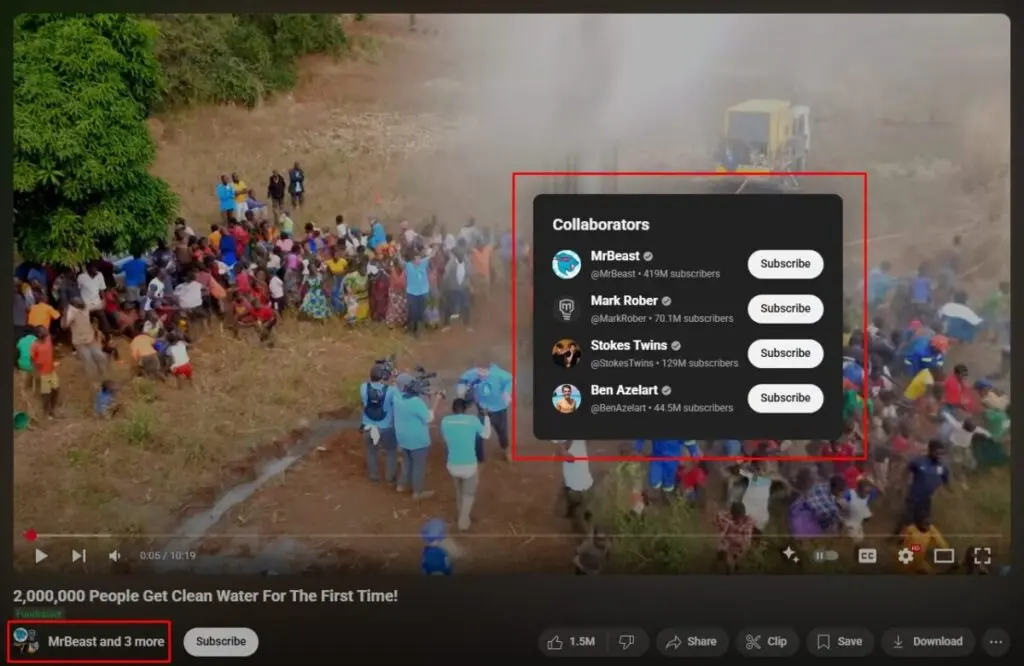- Collaborative Visibility: YouTube is piloting a tag system that displays all video collaborators’ avatars beside the title, making joint work immediately evident.
- Mutual Consent: The feature requires an invitation-and-accept workflow to ensure creators agree before their channel is credited on a collaborator’s clip.
- Audience Expansion: Tagged collaborators gain direct access to the lead creator’s audience, boosting cross-channel discovery and subscription potential.
- Future Potential: Early success may lead to deeper Studio integrations—shared analytics, revenue-sharing options, and collaborative playlists.
- Industry Alignment: This move aligns YouTube with Instagram and TikTok’s existing co-authoring tools, reflecting the growing importance of joint content across platforms.
A first look at YouTube’s pilot feature that lets multiple creators share credit—and audiences—on single videos.
When a beloved YouTuber like MrBeast releases a new clip, legions of subscribers race to watch. But until now, those collaborative videos have funneled attention solely to the lead channel.
YouTube’s latest experiment, however, introduces a simple yet powerful twist: creators can now formally tag their co-authors alongside the primary uploader, opening the door to shared visibility and more equitable audience growth.
A Long-Awaited Nod to Collaboration
Across social media, collaboration has become a central mode of content creation. Instagram pioneered joint posts called Instagram Collabs that carry multiple creator credits, and TikTok followed with dual-author uploads that surface each collaborator’s profile. YouTube’s decision to pilot a similar approach acknowledges both the prevalence and the promotional power of collaborative work on its own platform.
Until this test, co-created YouTube videos required creators to name partners in the description or pitch them verbally in the opening seconds. But buried text links and spoken shout-outs often disappeared beneath autoplay queues or viewer skimming.
By placing collaborator avatars directly beside the video title—and stacking them in a neat row—YouTube is making co-authorship immediately visible, on desktop and mobile alike.
One of the first public examples of this feature in action comes from MrBeast’s recent clip featuring Mark Rober, Ben Azelart, and the Stoke Twins. Viewers can now tap on the channel name to reveal each collaborator’s avatar, then navigate straight to their channels. This not only highlights every storyteller involved but also invites each creator’s community to engage with the content, turning one video into a shared discovery pathway.

Credit: MrBeast on YouTube
The addition of this co-authoring display also signals YouTube’s recognition that modern content often emerges from collective creativity rather than solo production. As audiences grow accustomed to seeing and celebrating multiple voices in a single frame, this formal tagging system promises to level the playing field—increasing transparency, crediting partners fairly, and giving every collaborator a stake in a video’s success.
Balancing Credit with Consent
Of course, with great visibility comes the risk of misattribution or unwanted tagging. YouTube anticipates this concern by requiring a mutual invite process. Only the uploader can request to add partners, and tagging does not take effect until each invitee explicitly accepts. This consent-based system ensures that creators cannot be arbitrarily associated with content or leveraged for exposure without their approval.
Such safeguards mirror established norms on other platforms, where collaborative tags demand co-creator agreement. By embedding permission checks into the flow, YouTube preserves trust among its community while extending collaboration benefits to all parties.
Why Shared Audiences Matter
The core appeal of this feature lies in audience crossover. Smaller or niche channels often struggle to break through YouTube’s vast sea of content. When they team up with a larger creator, however, their work can reach millions of new viewers.
Collaborative tagging ensures that the co-creator’s presence registers in recommendation algorithms and subscription prompts.
From a strategic standpoint, this can supercharge channel growth. Imagine a DIY craft channel partnering with a well-known lifestyle vlogger: the craft enthusiast gains immediate access to the vlogger’s audience, while the established creator benefits from authentic expertise. By formalizing these partnerships, YouTube not only rewards creative synergy but also strengthens community ties across genres.
Beyond Discovery: Potential Extensions
While the initial feature focuses on title display and navigation, its implications could expand far beyond simple tagging. Creators and marketers alike are already speculating on how shared authorship might tie into analytics or revenue sharing.
Could co-creators see view counts and subscriber gains reflected in their own dashboards? Might YouTube introduce collaborative playlists or co-managed live streams next?
Only time and user feedback will tell. YouTube has indicated that insights from the pilot group will shape future iterations, and that broader rollout is on the horizon. As the feature matures, deeper integration with YouTube Studio and analytics could follow, offering collaborators clearer metrics on joint performance.
A Collaborative Future for YouTube
By embracing formal collaboration tags, YouTube is both catching up with and distinguishing itself from other platforms. The change reflects an evolving understanding: modern content creation is rarely a solo endeavor.
Whether it’s a gaming duo showcasing new releases or a multi-expert panel dissecting current events, collaborative videos enrich the platform—and deserve recognition that drives real audience growth.
As this pilot progresses, creators and viewers alike will watch closely. If successful, the feature could foster a more interconnected YouTube ecosystem, where every voice in a collaboration stands to gain exposure, credit, and community. And for an industry built on shared creativity, that promise could usher in YouTube’s next era of collective storytelling.
Stay tuned as YouTube tests this feature with more creators, and prepare for a future where every tag truly counts.



